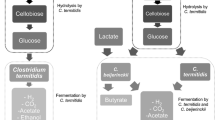Summary
The hydrolysis and fermentation of cellulose (Avicel) by continuous cultures of Ruminococcus albus strain 7 and Methanobrevibacter smithii strain PS were studied. Cellulose destruction ranged from ca. 22% to 71% for 0.25 to 2.27 days solids retention time, respectively. The cellulose hydrolysis rate constant (k) was 1.3 days−1. Concentrations of soluble reducing sugars were low, showing that cellulose hydrolysis was the rate-limiting step of cellulose fermentation. The estimated methane-based molar growth yield for M. smithii was 2.8 g mol−1. Its maximum specific growth rate was ca. 4 days−1. The dissolved H2 half-saturation constant (K s ) for methanogenesis was ca. 1 μM. The final products of the co-culture were primarily acetate, CH4 and CO2 and low levels of ethanol and H2. The co-culture produced more H2 (used for reduction of CO2 to CH4) and acetate than a monoculture of R. albus. These differences coulb be accounted for by the lower production of ethanol, confirming to the theory of interspecies H2 transfer.
Similar content being viewed by others
References
Ahring BK, Westermann P (1987) Kinetics of butyrate, acetate, and hydrogen metabolism in a thermophilic, anaerobic, butyrate-degrading triculture. Appl Environ Microbiol 53:434–439
Archer DB, Powell GE (1985) Dependence of the specific growth rate of methanogenic mutualistic cocultures on the methanogen. Arch Microbiol 141:133–137
Bryant MP, Wolin EA, Wolin MJ, Wolfe RS (1967) Methanobacillus omelianski: a symbiotic association of two species of bacteria. Arch Microbiol 59:20–31
Chung KT (1976) Inhibition effects of H2 on growth of Clostridium cellobioparum. Appl Environ Microbiol 31:342–348
Ehrlich GG, Goerlitz DF, Bourell JH, Eisen GV, Godsy EM (1981) Liquid chromatographic procedure for fermentation product analysis in the identification of anaerobic bacteria. Appl Environ Microbiol 42:878–885
Glass TL, Bryant MP, Wolin MJ (1977) Partial purification of ferredoxin from Ruminococcus albus and its role in pyruvate metabolism and reduction of nicotinamide adenine dinucleotide by H2. J Bacteriol 131:463–472
Gordon LI, Cohen Y, Standley DR (1977) The solubility of molecular hydrogen in seawater. Deep Sea Res 24:937–941
Hungate RE (1966) The rumen and its microbes. Academic Press, New York
Hungate RE (1967) Hydrogen as an intermediate in the rumen fermentation. Arch Mikrobiol 59:158–164
Hungate RE, Smith W, Bauchop T, Yu I, Rabinowitz JC (1970) Formate as an intermediate in the bovine rumen fermentation. J Bacteriol 102:389–397
Iannotti EL, Kafkewitz D, Wolin MJ, Bryant MP (1973) Glucose fermentation products of Ruminococcus albus grown in continuous culture with Vibrio succinogenes: changes caused by interspecies transfer of H2. J Bacteriol 144:1231–1240
Koeher LH (1952) Differentiation of carbohydrates by anthrone reaction rate and color intensity. Anal Chem 24:1576–1579
Kristjansson JK, Schönheit P, Thauer RK (1982) Different K s values for hydrogen of methanogenic bacteria and sulfate reducing bacteria: an explanation for the apparent inhibition of methanogenesis by sulfate. Arch Microbiol 131:278–282
Latham MJ, Wolin MJ (1977) Fermentation of cellulose by Ruminococcus flavefaciens in the presence and absence of Methanobacterium ruminantium. Appl Environ Microbiol 34:297–301
Ljungdahl LG, Eriksson KE (1985) Ecology of microbial cellulose degradation. Adv Microb Ecol 8:237–299
Loomis AG (1928) Solubilities of gases in water. In: Washburn EW (ed) International critical tables of numerical data, physics, chemistry and technology, 1st edn. McGraw-Hill, New York, pp 255–261
McInerney MJ, Bryant MP, Pfennig N (1979) Anaerobic bacterium that degrades fatty acids in syntrophic association with methanogens. Arch Microbiol 122:129–135
Miller TL, Wolin MJ (1981) Fermentation by the human large intestine microbial community in an in vitro semicontinuous culture system. Appl Environ Microbiol 42:400–407
Miller TL, Wolin MJ (1982) Enumeration of Methanobrevibacter smithii in human feces. Arch Microbiol 131:14–18
Miller TL, Wolin MJ, Kusel EA (1986) Isolation and characterization of methanogens from animal feces. Syst Appl Microbiol 8:234–238
Park JT, Johnson MJ (1949) A submicro-determination of glucose. J Biol Chem 181:149–151
Pavlostathis SG, Miller TL, Wolin MJ (1988a) Fermentation of insoluble cellulose by continuous cultures of Ruminococcus albus. Appl Environ Microbiol 54:2655–2659
Pavlostathis SG, Miller TL, Wolin MJ (1988b) Kinetics of insoluble cellulose fermentation by continuous cultures of Ruminococcus albus. Appl Environ Microbiol 54:2660–2663
Robinson JA, Tiedje JM (1982) Kinetics of hydrogen consumption by rumen fluid, anaerobic digestor sludge, and sediment. Appl Environ Microbiol 44:1374–1384
Scheifinger CC, Wolin MJ (1973) Propionate formation from cellulose and soluble sugars by combined cultures of Bacteroides succinogenes and Selenomonas ruminantium. Appl Microbiol 26:789–795
Scheifinger CC, Linehan B, Wolin MJ (1975) H2 production by Selenomonas ruminantium in the absence and presence of methanogenic bacteria. Appl Microbiol 29:480–483
Schönheit P, Moll J, Thauer RK (1980) Growth parameters (K s , μmax, Y s ) of Methanobacterium thermoautotrophicum. Arch Microbiol 127:59–65
Shea TG, Pretorius WA, Cole RD, Pearson EA (1968) Kinetics of hydrogen assimilation in the methane fermentation. Water Res 2:833–848
Somogyi M (1930) A method for the preparation of blood filtrates for the determination of sugar. J Biol Chem 86:655–663
Strayer RF, Tiedje JM (1978) Kinetic parameters of the conversion of methane precursors to methane in a hypereutropic lake sediment. Appl Environ Microbiol 36:330–340
Weimer PJ, Zeikus JG (1977) Fermentation of cellulose and cellobiose by Clostridium thermocellum in the absence and presence of Methanobacterium thermoautotrophicum. Appl Environ Microbiol 33:289–297
Wolfe RS (1971) Microbial formation of methane. Adv Microb Physiol 6:107–146
Wolin MJ (1974) Metabolic interactions among intestinal microorganisms. Am J Clin Nutr 27:1320–1328
Wolin MJ (1982) Hydrogen transfer in microbial communities. In: Bull AT, Slater JH (eds) Microbial interactions in communities, vol. 1. Academic Press, London, pp 323–356
Wood WA (1961) Fermentation of carbohydrates and related compounds. In: Gunsalus IC, Stanier RY (eds) The bacteria, vol. 2. Metabolism. Academic Press, New York, pp 59–149
Zhender A, Wuhrmann K (1977) Physiology of a Methanobacterium strain AZ. Arch Microbiol 111:199–205
Author information
Authors and Affiliations
Additional information
Offprint requests to: M. J. Wolin
Rights and permissions
About this article
Cite this article
Pavlostathis, S.G., Miller, T.L. & Wolin, M.J. Cellulose fermentation by continuous cultures of Ruminococcus albus and Methanobrevibacter smithii . Appl Microbiol Biotechnol 33, 109–116 (1990). https://doi.org/10.1007/BF00170581
Received:
Accepted:
Issue Date:
DOI: https://doi.org/10.1007/BF00170581




